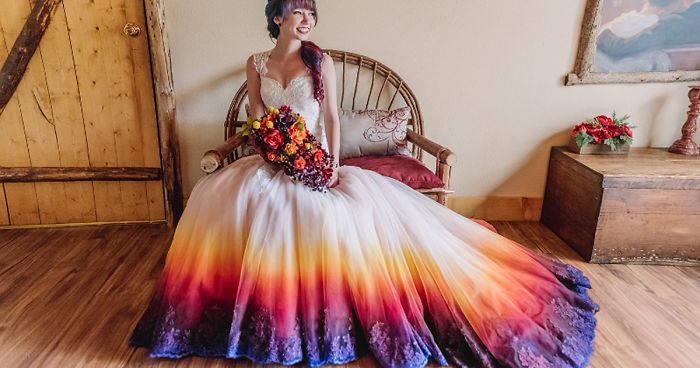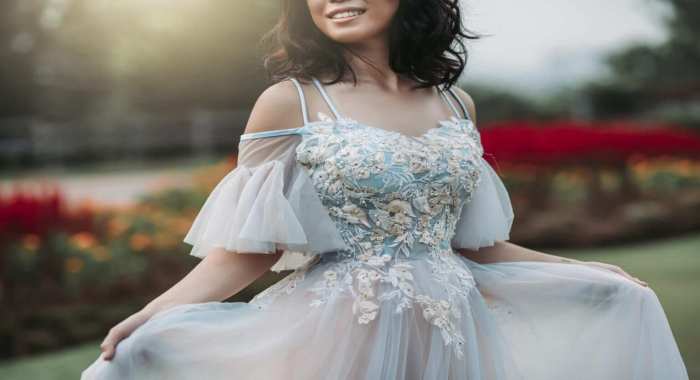Choosing the Right Dye for a Wedding Dress
How to dye a wedding dress – Selecting the appropriate dye is crucial for achieving a successful and lasting color change on your wedding dress. The choice depends heavily on the fabric composition and your desired outcome. Different fabrics react differently to various dyes, and using the wrong type can lead to uneven coloring, damage, or even ruin the dress entirely.
Dye Types and Fabric Compatibility
Several dye types are suitable for dyeing wedding dresses, each with its own strengths and weaknesses. Consider the fabric composition (silk, satin, lace, cotton, etc.) before making your selection. Improper dye selection can lead to unsatisfactory results.
| Dye Type | Fabric Compatibility | Pros | Cons |
|---|---|---|---|
| Fiber Reactive Dye | Cotton, linen, rayon, silk (with proper pretreatment) | Vibrant, long-lasting colors; good wash fastness. | Can be more expensive; requires specific pH levels for optimal results. |
| Acid Dye | Silk, wool, nylon | Produces bright, even colors; relatively easy to use. | May not be as colorfast as fiber reactive dyes; less suitable for cotton or linen. |
| All-Purpose Dye | Various fabrics (but results may vary) | Widely available and inexpensive. | Often produces less vibrant and less colorfast results; may require multiple applications. |
Professional vs. Home Dye Kits
Both professional and home dyeing kits offer options for dyeing a wedding dress. However, the choice depends on your experience level, budget, and desired level of control.
- Professional Dyeing: Offers superior results and color consistency, especially for delicate fabrics. Professionals have the expertise and equipment to handle complex dyeing processes. It’s more expensive, though.
- Home Dye Kits: More affordable and convenient, but may require more skill and precision to achieve professional-looking results. Careful attention to instructions is paramount.
Dye Color Selection

Source: boredpanda.com
Selecting the right dye color involves considering the fabric compatibility and your desired shade. Always test the dye on a hidden area of the dress first to ensure color accuracy and fabric compatibility. Refer to the dye manufacturer’s instructions for specific color recommendations and application techniques.
Preparing the Wedding Dress for Dyeing
Proper preparation is key to a successful dyeing process. Pre-treating the dress involves cleaning, stain removal, and testing the dye on an inconspicuous area. Safety precautions are crucial when handling dyes and chemicals.
Pre-Treatment Steps
Before dyeing, thoroughly clean the wedding dress to remove dirt, stains, and any previous treatments that may interfere with dye absorption. Use a mild detergent suitable for delicate fabrics and follow the care instructions on the dress’s label. Address any stains before dyeing, as the dye may not completely cover them.
Dye Test
Always test the dye on a hidden area of the dress (like an inside seam) before proceeding with the full dyeing process. This allows you to check for color accuracy, assess dye absorption, and ensure the dye doesn’t damage the fabric.
Safety Precautions, How to dye a wedding dress
When handling dyes and chemicals, wear protective gloves, eye protection, and a mask to avoid skin and respiratory irritation. Work in a well-ventilated area to prevent inhaling dye fumes. Keep children and pets away from the dyeing area.
Pre-Dyeing Checklist
- Clean the dress thoroughly.
- Remove any stains.
- Test the dye on a hidden area.
- Gather necessary supplies (dye, gloves, protective eyewear, etc.).
- Prepare the dyeing area with adequate ventilation.
Dyeing the Wedding Dress: Methods and Techniques
Several methods exist for dyeing a wedding dress, each with its own advantages and disadvantages. Immersion dyeing is a common and effective method, but other techniques, such as tie-dyeing, can be used to create unique effects. Achieving even color distribution is crucial for a professional look.
Immersion Dyeing
Immersion dyeing involves submerging the entire dress in a dye bath. This method is suitable for achieving an even, consistent color throughout the garment. It requires careful preparation and attention to detail to avoid dye streaks or uneven coloring.
Visual Guide to Immersion Dyeing
1. Preparation: The dress is thoroughly cleaned and pre-treated. A suitable dye bath is prepared according to the manufacturer’s instructions. The dye bath is heated to the recommended temperature, ensuring even distribution of the dye.
2. Submersion: The wedding dress is carefully submerged into the dye bath, ensuring complete immersion. The dress is gently agitated to promote even dye penetration.
3. Dyeing Time: The dress is left to soak in the dye bath for the recommended time, allowing the fibers to absorb the dye fully. The temperature is maintained consistently throughout the dyeing process.
4. Rinsing: After the dyeing time, the dress is carefully removed and rinsed thoroughly with cool water until the water runs clear. This removes excess dye and prevents further staining.
5. Final Rinse: A final rinse with a fabric softener solution helps to condition the fabric and enhance its softness.
Tips for Even Color Distribution

Source: bridalnotes.com
- Ensure complete submersion of the fabric in the dye bath.
- Gently agitate the fabric throughout the dyeing process.
- Maintain a consistent temperature during dyeing.
- Rinse thoroughly to remove excess dye.
Post-Dyeing Care and Maintenance
Proper care and maintenance are essential to preserve the color and condition of your newly dyed wedding dress. This includes using specific detergents, fabric softeners, and storage techniques to prevent fading and damage. Following these guidelines will ensure your dress remains vibrant and beautiful for years to come.
Washing and Rinsing
After dyeing, gently hand-wash the dress in cool water with a mild detergent specifically designed for delicate fabrics. Avoid harsh chemicals or abrasive cleaning agents that could damage the fibers or fade the color. Rinse thoroughly until the water runs clear.
Detergents and Fabric Softeners
Use only pH-neutral detergents and fabric softeners formulated for dyed fabrics. Avoid using bleach or any products containing harsh chemicals, as these can damage the fibers and cause color fading.
Storage and Maintenance
Store the dyed wedding dress in a cool, dark, and dry place away from direct sunlight or heat. Use acid-free tissue paper to prevent yellowing or discoloration. Avoid folding the dress sharply, as this can cause creases and damage the fabric.
Dos and Don’ts for Dyed Wedding Dress Care
- Do: Hand-wash gently with a mild detergent.
- Do: Rinse thoroughly with cool water.
- Do: Store in a cool, dark, and dry place.
- Don’t: Use bleach or harsh chemicals.
- Don’t: Machine wash or dry clean.
- Don’t: Expose to direct sunlight or heat.
Troubleshooting Common Dyeing Problems

Source: talu.earth
Even with careful preparation and execution, some dyeing problems may occur. Understanding these issues and their solutions is essential for achieving satisfactory results. Addressing problems promptly can minimize damage and maintain the quality of the dyed garment.
Common Dyeing Issues and Solutions
Uneven Color: This often results from insufficient dye penetration or uneven agitation during the dyeing process. Re-dyeing with a fresh batch of dye, ensuring complete submersion and gentle agitation, may resolve the issue.
Color Fading: This can be caused by using unsuitable detergents, exposure to sunlight, or improper storage. Using pH-neutral detergents and storing the dress in a cool, dark place will help prevent fading.
Dye Color Too Light: This may be due to insufficient dye concentration or inadequate dyeing time. Re-dyeing with a stronger dye concentration or extending the dyeing time may help.
Dye Color Too Dark: This may be due to an excessive dye concentration or prolonged dyeing time. The color may be difficult to lighten; professional intervention may be required.
Addressing Dyeing Mistakes
Depending on the severity of the mistake, various approaches can be used. Minor issues, such as slight color unevenness, may be addressed with re-dyeing or spot treatment. Significant issues, like major color discrepancies, may require professional intervention for correction or restoration.
FAQ: How To Dye A Wedding Dress
Can I dye a beaded wedding dress?
Dyeing a wedding dress requires careful consideration of the fabric and desired color. The process can be surprisingly straightforward, even for intricate designs like a stunning high neck open back wedding dress , though delicate fabrics might need professional attention. Remember to always test a hidden area first before committing to a full dye job to avoid any surprises with the final result.
Successful dyeing hinges on preparation and a gentle approach.
Beads may be affected by the dye; test a hidden area first. Some beads may be colorfast, while others may be damaged or change color. Proceed with caution.
How long does the dye process take?
The total time varies depending on the method and dye used, but expect to spend several hours, including preparation, dyeing, and rinsing.
What if the dye color is too dark?
Try re-dyeing with a color remover or bleach (test in an inconspicuous area first). This is a delicate process and may require professional help.
Can I use a washing machine to rinse the dress?
It’s best to hand-wash and rinse to avoid damaging the fabric or causing uneven color. Use cool water and a gentle detergent.
How can I prevent color fading?
Use color-safe detergent, avoid direct sunlight, and store the dress in a cool, dark place. Consider using a garment bag.
